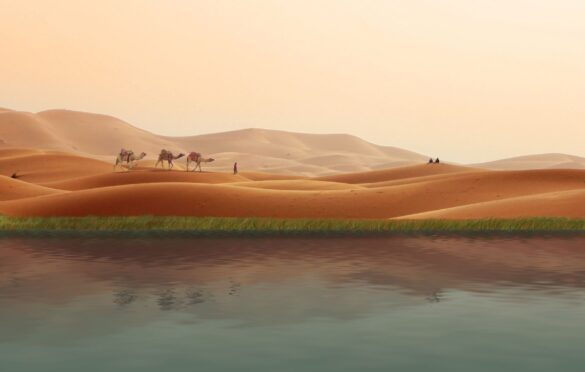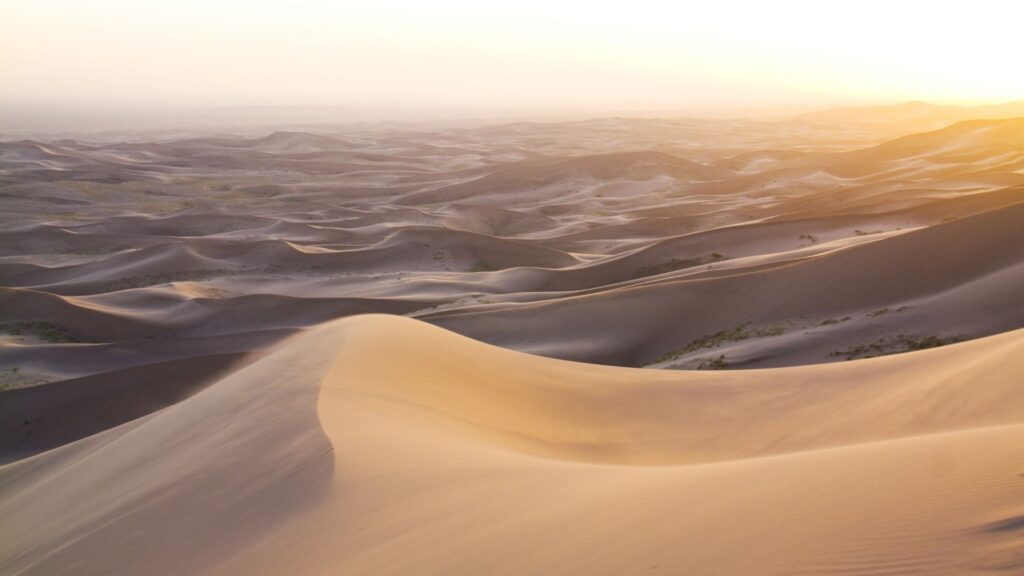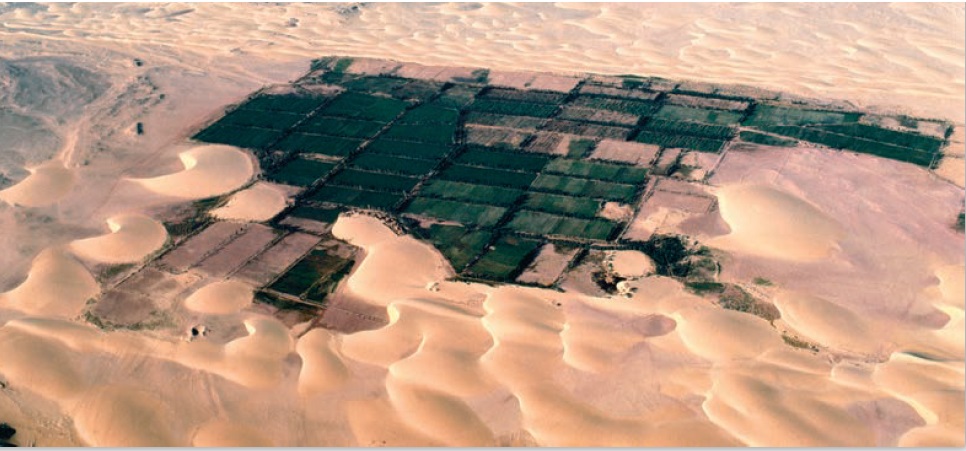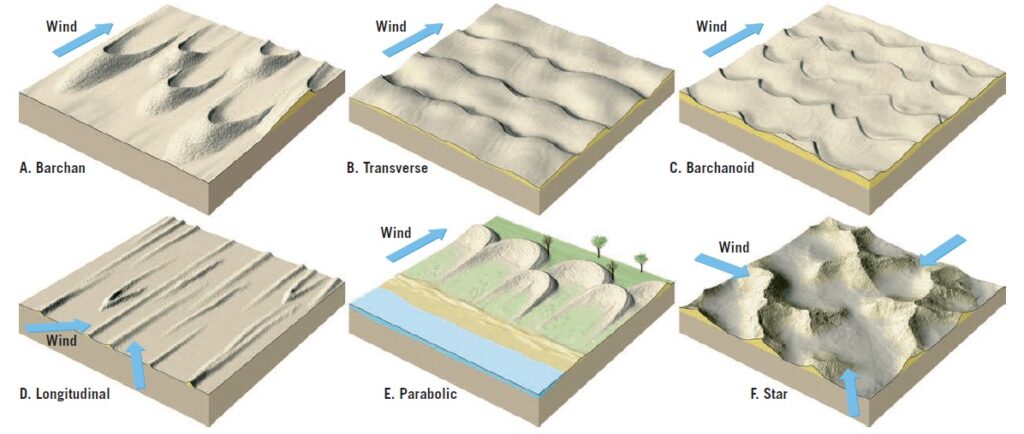Types of Sand Dunes: Discovering Nature’s Dynamic Creations

Introduction
Sand dunes are captivating natural formations that dot landscapes across the world. From vast deserts to coastal regions, these dynamic structures have been shaped by the forces of nature over millions of years. In this article, we will delve into the intriguing world of sand dunes, exploring what they are, how they form, the different types that exist, their geographical distribution, and even the unique life that thrives within these sandy landscapes.

What are Sand Dunes?
At their core, sand dunes are mounds of sand that have been shaped and shifted by wind and water. The sand particles that compose these formations are usually quartz-based, resulting from the weathering and erosion of rocks over time. As wind currents blow across sandy surfaces, they carry loose sand particles and deposit them in specific areas, gradually building up these dunes.

How are Sand Dunes Formed?
The formation of sand dunes is a fascinating process that involves several key factors. First and foremost, a source of dry sand is necessary, which is typically provided by exposed beaches, riverbeds, or deserts. As wind blows over these sandy surfaces, it picks up loose grains and transports them. When the wind encounters an obstacle, such as vegetation or rocks, it slows down, causing the sand to be deposited, forming the initial small dunes called “embryonic dunes.”

Over time, these embryonic dunes grow in size and become “parabolic dunes” due to the stabilizing effects of vegetation. As the vegetation anchors the sand, it forms a crescent-shaped dune with the open end pointing into the direction of the prevailing wind.
With further accumulation of sand, the parabolic dunes evolve into “transverse dunes,” which appear as long ridges parallel to the direction of the prevailing wind. As the process continues, various dune types like “barchan dunes,” “star dunes,” and “longitudinal dunes” can form, depending on the specific wind patterns and environmental conditions.
Types of Sand Dunes
Barchan Dunes
Barchan dunes are solitary crescent-shaped dunes that resemble a convex lens. These dunes are commonly found in arid regions with consistent winds and limited sand availability. The “horns” of the crescent point downwind, and these dunes typically move slowly across the landscape.
Transverse Dunes
Transverse dunes, also known as “ridge dunes,” form perpendicular to the prevailing wind direction. They are characterized by long, parallel ridges that extend across vast expanses of sandy terrain. These dunes are often found in areas with moderate sand availability and consistent winds.

Barchanoid Dunes
Barchanoid dunes are a hybrid of barchan and transverse dunes. They possess characteristics of both types, with a crescent shape and elongated ridges extending diagonally from the horns. Barchanoid dunes form in areas where wind patterns can change over time.
Longitudinal Dunes
As the name suggests, linear dunes are long, straight dunes that form parallel to the direction of the prevailing winds. They are commonly found in areas with unidirectional winds, such as along coastlines or in flat desert plains.
Parabolic Dunes
Unlike the other dune types described thus far, parabolic dunes form where vegetation partially covers the sand. The shape of these dunes resembles the shape of barchans except that their tips point into the wind rather than downwind. Parabolic dunes often form along coasts where there are strong onshore winds and abundant sand. If the sand’s sparse vegetative cover is disturbed at some spot, deflation creates a blowout. Sand is then transported out of the depression and deposited as a curved rim, which grows higher as deflation enlarges the blowout.
Star Dunes
Star dunes are complex and striking formations with multiple arms extending in different directions. Their shape is influenced by variable wind directions and abundant sand availability. These dunes can grow to considerable heights and are found in diverse desert regions.
Where are the Most Sand Dunes?
Sand dunes can be found on every continent except Antarctica. However, some regions boast an impressive concentration of these sandy formations:
Sahara Desert, Africa: The Sahara Desert is the largest hot desert in the world, covering vast areas of northern Africa. It is home to some of the most extensive and iconic sand dunes, including the renowned “Erg Chebbi” dunes in Morocco.
Rub’ al Khali (Empty Quarter), Arabian Peninsula: This desert is one of the largest continuous sand deserts on the planet, covering parts of Saudi Arabia, Oman, Yemen, and the United Arab Emirates.
Namib Desert, Namibia: The Namib Desert is known for its breathtaking landscapes, including the iconic red sand dunes of Sossusvlei and Deadvlei.
Atacama Desert, Chile: Despite being one of the driest places on Earth, the Atacama Desert harbors unique sand dune formations, such as the Cerro Blanco dune, the highest in the world.
Great Sand Dunes National Park, USA: Located in Colorado, USA, this national park boasts some of the tallest sand dunes in North America, offering visitors a diverse desert experience.

Life on Sand Dunes
Contrary to their barren appearance, sand dunes are teeming with life that has evolved to adapt to the harsh conditions. Many plant and animal species have developed remarkable survival strategies to thrive in sandy environments:
Xerophytes: Xerophytic plants are well-adapted to arid conditions and are commonly found on sand dunes. These plants have evolved features like deep root systems to access water, reduced leaf surfaces to minimize water loss, and mechanisms to store water during periods of drought.
Dune Fauna: Several animal species have also adapted to life on sand dunes. Creatures such as the sand gazelle, sidewinder snake, and sand skink have evolved specialized traits to navigate the shifting sands and scorching temperatures.
Sand Dune Microorganisms: Microbial life in the form of bacteria, fungi, and algae can be found beneath the surface of sand dunes. These microorganisms play essential roles in stabilizing the dunes and contributing to nutrient cycling in the ecosystem.
Conclusion
Sand dunes are marvels of nature, shaped by the invisible forces of wind and time. From the majestic dunes of the Sahara to the striking landscapes of Namibia, each type of sand dune has its unique charm and characteristics. As we explored in this article, sand dunes are more than just sandy mounds; they are dynamic ecosystems that support a diverse array of life forms.
Next time you encounter a sand dune, take a moment to appreciate the intricate processes that have sculpted these natural wonders. The more we understand and respect the delicate balance of sand dune ecosystems, the better we can preserve and protect them for generations to come. So, whether you’re an adventurous traveler or an inquisitive nature enthusiast, sand dunes have something magical to offer, inviting you to explore and discover their hidden treasures.
